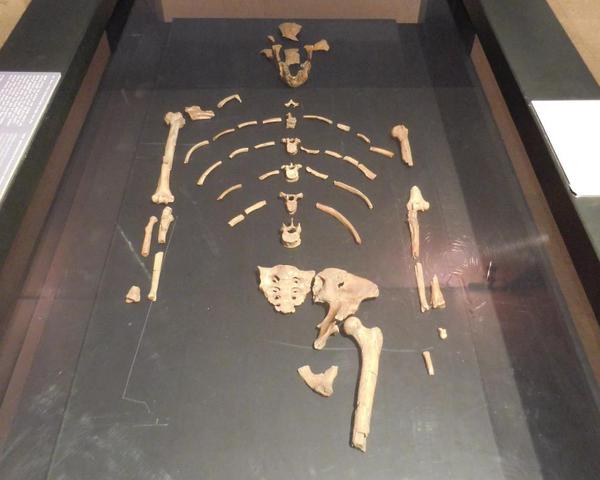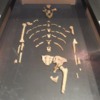In the center of Addis Ababa is the Ethiopian National Museum. It's supposed to be constructed as an Italian villa, although I am not so sure I see that. Although it has been around for decades (1930’s), it was in the mid-1970s that the government supported the idea of having a National Museum that would exhibit the various objects that had been discovered at the archeological and anthropologic excavation sites around the country. Specifically, there was the idea to protect and preserve the various antiquities of the country, the archeological sites in Ethiopia, and not just those that had already been excavated.
Presently, there are three major sections to the museum, including conservation, exhibition and research components. While the museum is separated into 4 main exhibition areas, it is the “Lucy” exhibit that draws the most people.
The basement houses the various archaeological and paleoanthropological findings from Ethiopia, specifically including the various hominid findings, while the other floors contain the regalia and memorabilia from Emperor Haile Selassie (donated by the royal family back in the 1930’s as part of the original exhibitions in the museum), and various ethnic and cultural artifacts of the Ethiopian people.
(the remains of "Lucy")
It goes without saying that being able to see the actual fossilized remains of early hominids up close is quite remarkable. Having visited the Dinosaur Provincial Park in Canada just last year, this is another treat along the same lines. The most famous finding on display is “Lucy” or “Dinkinesh” in Amharic (meaning, “you are marvelous"), the most complete (although still partial) skeletal remains of an early hominid, named Australopithecus afarensis.
(Lucy's Jaw)
Found within Ethiopia, Kenya and Tanzania, A. Afarensis is thought to be the ancestral origins of humans. It represents approximately 40% of a female skeleton. It was discovered at Hadar in the Awash River Valley in Ethiopia in 1974. This particular region has actually been the most abundant fossil bed for these early species. What makes this particular find so unique in paleoanthropology is the relative completeness of the skeleton. In general, a jaw, a few ribs or a femur are discovered, but in this case, nearly 40% of the entire skeletal remains were found. While I am a creationist by belief, there is a claim the fossilized material is 3.2 million years old. She stood about 105 cm tall, although this was considered short and petite for the species. The shape of the pelvis is used to suggest female instead of male. The wisdom teeth were in place, but not worn, suggesting a young adult at the time of her death. The mandible was thrust quite far forward, more similar to apes than humans. Also, the small skull seems similar to apes, but the bipedal upright stances is more that of a human, and thus it is considered an “early” hominid.
It is very difficult to photograph "Lucy" as it is behind heavy Plexiglas with many spotlights shining on it. However, there is also a wonderful plaster replica that is shown in bipedal upright stance, giving you a better idea of the size, shape and overall appearance of the hominid. It is quite ironic to me that I am seeing Lucy for the first time here in Ethiopia were she was discovered, even though from 2007 to 2013 the remains toured the United States as part of an exhibit, “Lucy’s Legacy.” It is always better to me to actually see something where it was discovered and without all of the fanfare that often accompanies a US exhibition.
Of further interest are several other early hominids, including Selam (meaning peace in Ethiopia), excavated during 2004 in the same general region, and thought to be the best preserved child of this same species. She is thought to be about 3 years old when she died, but about 150,000 years before Lucy! Finally, it was also fun to see Homo Rhodesiensis, a fossil skull found in Rhodesia (which is where I was born), though to be similar to the European Homo Heidelberegensis, an early Neanderthal.
My Dad has a great interest in paleoarcheology, so I have grown up with some knowledge about various fossil and paleoanthropology finds. Very fun to be able to see the remains in person after only seeing them in pictures up to this point! Of course, I spent some time in the rest of the museum, which showed various ethnographic objects from Ethiopian culture, including donations from the Emperor, woven baskets, and head rests, musical instructions and murals. However, these objects did not hold nearly the allure of the fossils.
Dr. Thompson's Ethiopia series concludes next week, with 7) The Money.
- For part 1, Getting to Addis, click here
- For part 2, Languages and people, click here
- For part 3, Time and date, click here
- For part 4, The Food, click here
- For part 5, Visiting the Rift Valley, click here



Comments (0)